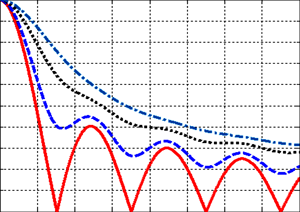Performance characterization of MIMO channels with hybrid diversity
DOI:
https://doi.org/10.3103/S0735272719060049Keywords:
XPD, NLOS, CPR, MIMO, multiple-input multiple-output system, non-line-of-sight operation, hybrid diversity, dual polarized diversity, spatial diversity, cross-polar discrimination, co-polar ratioAbstract
Recent advances have demonstrated that multiple-input multiple-output (MIMO) wireless technology can achieve impressive enhancement in overall system performance. It offers spatial multiplexing and spatial diversity without increasing either the total system power nor the bandwidth and thus offering the potential for substantial improvements in channel capacity and spectral efficiency. However, the high dependence of its channel capacity on the correlation between antenna elements represents the main drawback of MIMO systems. Therefore, multi-polarized antennas have been implemented in these systems to reduce the antenna correlation and realize compact devices. This article is intended for the hybrid diversity (space and polarization) performance analysis of MIMO channels in indoor environment under non-line-of-sight (NLOS) condition. It investigates the effect of inter-element spacing on the cross-polar discrimination (XPD) and co-polar ratio (CPR). In this regard, the capacity as well as bit error rate (BER) performance of hybrid MIMO system is analyzed to draw a fair comparison between it and dual polarized along with spatial diversity techniques. The simulation results show that the hybrid diversity has a middle performance between these two scenarios of system implementations. Additionally, the performance of hybrid diversity is clearly enhanced in comparison with the dual polarized condition of operation, as the separation between the antennas increases. Moreover, as a function of the antenna separation, the spatial diversity system performance is varying slower than that of hybrid diversity case.References
- TELATAR, I.E. “Capacity of multi-antenna Gaussian channels,” Trans. Emerging Telecom. Tech., v.10, n.6, p.585, 1999. DOI: https://doi.org/10.1002/ett.4460100604.
- CHIZHIK, D.; RASHID-FARROKHI, F.; LING, J.; LOZANO, A. “Effect of antenna separation on the capacity of BLAST in correlated channels,” IEEE Commun. Lett., v.4, n.11, p.337, Nov. 2000. DOI: https://doi.org/10.1109/4234.892194.
- ANREDDY, V.R.; INGRAM, M.A. “Capacity of measured Ricean and Rayleigh indoor MIMO channels at 2.4 GHz with polarization and spatial diversity,” Proc. of IEEE Wireless Commun. and Networking Conf., 3-6 Apr. 2006, Las Vegas, USA. IEEE, 2006, v.2, p.946-951. DOI: https://doi.org/10.1109/WCNC.2006.1683597.
- SHIU, D.-S.; FOSCHINI, G.J.; GANS, M.J.; KAHN, J.M. “Fading correlation and its effect on the capacity of multi-element antenna systems,” IEEE Trans. Commun., v.48, n.3, p.502, Mar. 2000. DOI: https://doi.org/10.1109/26.837052.
- RAOOF, K.; ZHOU, H. Advanced MIMO Systems. Sci. Res. Pub., Inc., 2009.
- JOMON, K. Charly; PRASANTH, S. “Joint channel estimation and data detection in MIMO-OFDM using distributed compressive sensing,” Radioelectron. Commun. Syst., v.60, n.2, p.80, 2017. DOI: https://doi.org/10.3103/S0735272717020029.
- KREYNDELIN, V.B.; BEN REJEB, T.B.K. “Nonlinear iterative precoding algorithm for MIMO multiuser systems,” Radioelectron. Commun. Syst., v.60, n.10, p.449, 2017. DOI: https://doi.org/10.3103/S073527271710003X.
- CHAUHAN, D.V.; BHALANI, J.; TRIVEDI, Y.N. “Improved VBLAST MAP: A novel point-to-point symbol detection algorithm for MIMO wireless communication systems,” Radioelectron. Commun. Syst., v.61, n.5, p.194, 2018. DOI: https://doi.org/10.3103/S0735272718050023.
- ABDI, A.; KAVEH, M. “A space-time correlation model for multi-element antenna systems in mobile fading channels,” IEEE J. Select. Areas Commun., v.20, n.3, p.550, 2002. DOI: https://doi.org/10.1109/49.995514.
- DUONG, T.Q.; TRANG, H.; HONG, E.K.; LEE, S.Y. “Performance evaluation of the V-BLAST system under correlated fading channels,” Proc. of AICT/SAPIR/ELETE 2005, 17-20 Jul. 2005, Lisbon, Portugal. IEEE, 2005, p.220-225. DOI: https://doi.org/10.1109/AICT.2005.71.
- OESTGES, C.; CLERCKX, B.; GUILLAUD, M.; DEBBAH, M. “Dual-polarized wireless communications: from propagation models to system performance evaluation,” IEEE Trans. Wireless Commun., v.7, n.10, p.4019, Oct. 2008. DOI: https://doi.org/10.1109/T-WC.2008.070540.
- HABIB, A.; MEHLFÜHRER, C.; RUPP, M. “Performance of compact antenna arrays with receive selection,” Proc. of 7th IEEE Int. Conf. on Wireless Advanced, 20-22 Jun. 2011, London, UK. IEEE, 2011, p.207-212. DOI: https://doi.org/10.1109/WiAd.2011.5983312.
- NAM, Junyoung; CAIRE, Giuseppe; HA, Jeongseok. “On the role of transmit correlation diversity in multiuser MIMO systems,” IEEE Trans. Inf. Theory, v.63, n.1, p.336, Jan. 2017. DOI: https://doi.org/10.1109/TIT.2016.2615627.
- CASTEL, Thijs; LEMEY, Sam; VAN TORRE, Patrick; OESTGES, Claude. ROGIER, Hendrik. “Four-element ultrawideband textile cross array for dual-spatial and dual-polarization diversity,” IEEE Antennas Wireless Propag. Lett., v.16, p.481, Jun. 2016. DOI: https://doi.org/10.1109/LAWP.2016.2585308.
- PAPAMICHAEL, Vasilis; KARADIMAS, Petros. “On the covariance matrix and diversity performance evaluation of compact multiport antenna systems,” IEEE Trans. Antennas Propag., v.65, n.11, p.6140, Nov. 2017. DOI: https://doi.org/10.1109/TAP.2017.2754439.
- GOLDSMITH, A. Wireless Communications. CUP, 2005. DOI: https://doi.org/10.1017/CBO9780511841224.
- HAI, L.; ZHANG, Y.-R. “A new statistical channel model for hybrid-diversity MIMO systems,” Circuits Syst. Signal Process., v.31, n.6, p.2093, 2012. DOI: https://doi.org/10.1007/s00034-012-9418-x.
- YU, Kai; BENGTSSON, M.; OTTERSTEN, B.; MCNAMARA, D.; KARLSSON, P.; BEACH, M. “Second order statistics of NLOS indoor MIMO channels based on 5.2 GHz measurements,” Proc. of IEEE Global Telecommunications Conf., 25-29 Nov. 2001, San Antonio, USA. IEEE, 2001, v.1, p.156-160. DOI: https://doi.org/10.1109/GLOCOM.2001.965098.
- HE, Y.; CHENG, X.; STUBER, G.L. “On polarization channel modeling,” IEEE Wireless Commun., v.23, n.1, p.80, Feb. 2016. DOI: https://doi.org/10.1109/MWC.2016.7422409.
- LIM, Y.-G.; CHO, Y.J.; OH, T.; LEE, Y.; CHAE, C.-B. “Relationship between cross-polarization discrimination (XPD) and spatial correlation in indoor small-cell MIMO systems,” arXiv preprint, 2017. URI: https://arxiv.org/abs/1707.00227.
- TSEN, W.F.; LI, H.-J. “Correlations and channel capacities for multi-polarized MIMO systems,” Proc. of IEEE 20th Int. Symp. on Personal, Indoor and Mobile Radio Communications, Tokyo, Japan. IEEE, 2009, p.1069-1073. DOI: https://doi.org/10.1109/PIMRC.2009.5450233.

Downloads
Published
2019-07-05
Issue
Section
Research Articles

